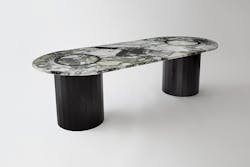It's rare to find a one-man operation, or in this case, one woman. But designer and maker Kate Casey makes it look easy in her Brooklyn-based studio, Peg Woodworking.
Born and raised in Berkshires, Mass., Casey moved to Brooklyn, NY in 2009 after completing her undergraduate education at Massachusetts College of Art and Design (BFA) and the Yale Norfolk School of Art. She worked as a fabricator for sculptor Matthew Day Jackson where she underwent the Center for Furniture Craftsmanships intensive program to hone in more specifically on woodworking and design.
Since starting Peg Woodworking in 2014, Casey has kept it as a one-woman-run operation. All collections are customizable in shape, size and color and are available to the trade as well as consumers. Each design is approached with the utmost attention to form and function. Paying tribute to the clean lines and intricate weaving found in Shaker and Scandinavian design, Peg Woodworking provides a contemporary take on the traditional.
While gathering pattern inspiration from Peruvian and American Indian weaving, each piece is hand woven in-house with a unique array of patterns and colors. Through combining the intricate aesthetics of the hand weaving with the angular geometry and clean lines of the woodworking each piece finds a harmonious balance of bold and delicate details.
Learn more about Casey and Peg Woodworking in our latest Maker Monday Q&A below.
What inspires you?
I love to steal shapes from architectural sources challenging myself to design a piece based on a curve or some small architectural detail. I like the resolution of function and sculpture that takes place in both furniture and architecture.
What is your most memorable product or collection you’ve worked on and why?
My more recent work was really exciting for me because I tried to use woodworking skills and materials that I have wanted to challenge myself with for some time. I tried to introduce different techniques that I had not been confident enough to try in the past. I tend to be most excited about my newest work and try to keep it exciting and challenging for myself.
Describe what a typical work day for you looks like.
Most commonly, I wake up and follow up on emails before heading onto my shop. I like to leave the computer at home to separate my tasks from one another and allow my full focus at both places. I fill orders during the day and if I have a minute I work on some new pieces that are constantly being tweaked and worked on. I head home and handle the correspondence I've gotten during the day. The routine varies - some days I have pieces to deliver, some days upholstery to pick up or lumber to buy. I used to work through weekends, but I realized that's a good way to burn out and resent the work so I try and keep my work days to at most six a week.
Name some must-haves you need or like to have on-hand when starting a new project.
Grid paper for sketching. It helps me solidify proportions more accurately. It also helps when I'm drawing out new patterning options which have to be to scale in order to fit on the frames. I also keep a tiny tape measure on me all the time, this is great to see scale of a proposed piece in real space. They are also great for calculating lumber needs on the fly. When I am starting a new pattern the small tape measure helps me confirm that the weaving will fit within the framework of the specific piece. I use both at the design and weaving phase of the work and are always on hand.
What challenges you most during your creative process?
Finding the balance between a harmonious object and a functional object is often quite difficult. I like the challenge, but it is one thing to make something beautiful and another to make it functional...to find the place where they effortlessly meet can be complicated.
What is your favorite thing in your working environment?
I have a home studio, separate from my woodshop, for the woven work. It is quiet, clean, and a nice break from the dusty loud shop. The dual practices make me feel more balanced.
What’s your favorite color?
I can honestly say I have never had one and the front runners are always changing. Right now I'm into brick red.
What is your favorite design era?
Deco for sure. As far as architecture and decor I find it infinitely interesting both in its minimalism and ornamentation, I like that dichotomy.
Who has helped you realize your dreams?
I did have an amazing high school art teacher. He is incredibly talented and very blunt. I needed to see that a career in art/design was possible at that point to even consider it an option and he was the encouragement that sent me down this path.
What do you think is next for the interior design industry?
I like how social media has helped with sourcing and introducing new designers to industry heads. It is all around beneficial platform that democratizes aspects of the industry to younger and lesser-known makers.
What’s next for you?
I hope to expand in the near future. I have an amazing part time assistant at the moment and we are both kept very busy. Hopefully soon I can hire additional help and focus more heavily on designing new work.
Where can people find your goods?
Direct inquiries from Peg Woodworking.
Beyond Woodworking. interiors+sources NeoCon Coverage: New Products | Twitter | Breaking News
About the Author

Adrian Schley
Associate Editor
Adrian Schley was an Associate Editor for i+s, where she covered the commercial interior design industry since 2018. Her work can also be found in BUILDINGS and Meetings Today.
